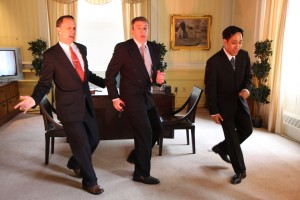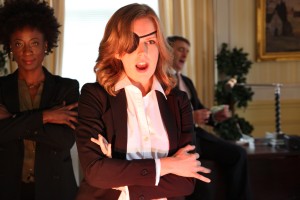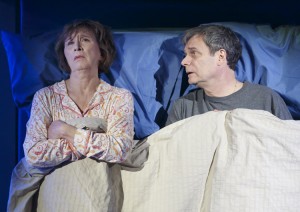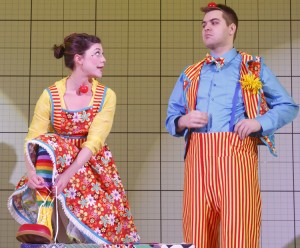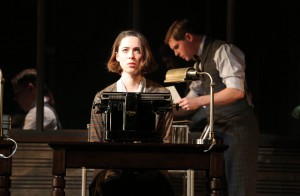The lights are dimmed, the room is silent. “You can sit here,” the usher says. “Oh, and don’t forget this.” As if it came out of thin air, it appears between his finger tips and he places it in the palm of my hand. I look down, and there it is — a bright red clown nose. I look up and realize that everyone in the room is a clown with the same red nose. I look back and a clown appears out of the darkness into the doorway I had just walked through. I knew then that this was not a regular clown act.
Now I know what you are thinking, and no, this was not a nightmare. It was the set of Clown Bar — a show about a cop named Happy Mahoney who returns to his old clown life to figure out the murder of his brother, Timmy, and seek revenge. Written by Adam Szymkowicz, this play combines the visual familiarity of the bright clown costumes and exaggerated clown make–up with the 1930s gangster’s ambiance.
In this performance directed by Andrew Neisler, the audience is introduced to the world of the play with red noses of their own, waitresses dressed in proper clown attire, and a 15-to-30 minute pre-show. The stage is set up so the actors have the space to perform on a small stage at the very end of the room, as well as walk up and down the center row of a very cozy bar. From the beginning to end, the vibrant costumes and well-designed set captures your eyes. Throughout the show, the lighting perfectly frames the actors to help the audience look in the right direction while the mime pianist makes you laugh as he plays the appropriate tune to set the mood or to help support a singing number.
Credit must also be given to the actors on the stage. With a straight face, the cast delivers ironic word play, double entendres, puns and even bad jokes that keep the audience in their seat wanting more. To be able to get the audience’s attention no matter where in the room they deliver a line is a reflection of their talent. Clowns such as Petunia (played by Jessica Frey) and Dusty (played by Salty Brine), catch your attention and make you fall in love with their characters, no matter how many clowns they may or may not have killed that day.
The only warning I give to you is to be careful where you sit. On the one hand, while the cozy atmosphere of the bar adds to the world of the play, it causes some audience members to have partial view. For example, although it's exciting to sit on the small stage to be close to the action, depending on the angle, some of the staging can be lost if you are too close or too far away.
On the other hand, by sitting that close to the action, you are able to interact with the actors. While some audience members are sprinkled with the glitter of the gun shots, others become a part of the act.
Overall, these criminal clowns are successfully able to take the audience on a ride into the underbelly of clown crime in order to solve the murder of Timmy Mahoney — the unfunny clown. Although I only chuckled a few times, the impressive set, costume and talent makes it worthwhile show. Just be ready for puns and a room full of clowns — and don’t say I didn’t warn you.
Clown Bar ran through Sept. 27 at The Box (189 Chrystie St. between Stanton and Rivington).









